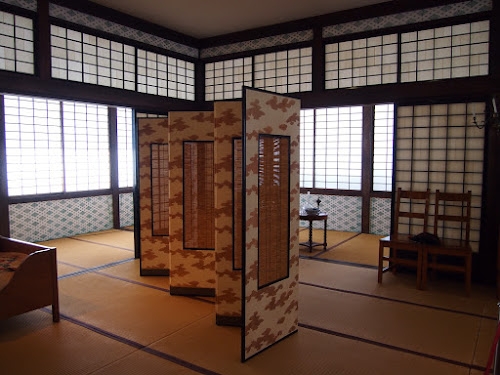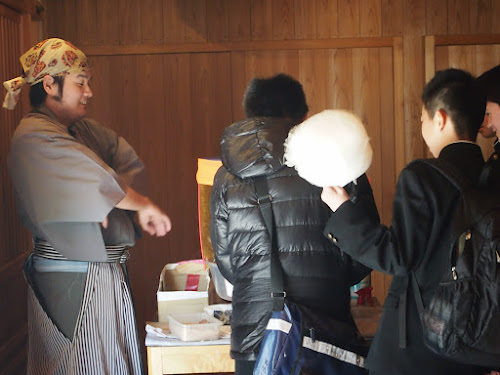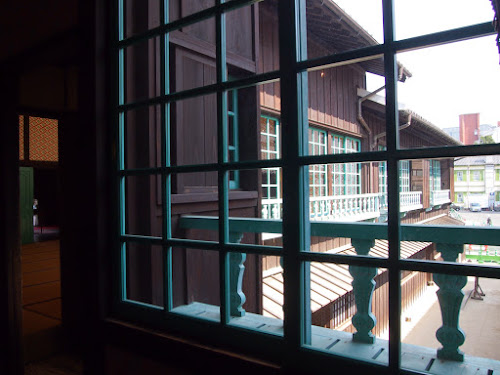Nagasaki has a lot to offer for a small city. Perhaps that’s why it seemed to be full of Japanese tourists, clutching their one day passes, just as uncertain about the streetcar route as we were.
Dejima had been an artificial island ordered constructed just off Nagasaki in 1634 by Shogun Tokugawa Ieyasu to isolate foreigners, specifically the merchants and seamen facilitating the trickle of foreign trade. (You may remember Tokugawa from some of our postings in 2013.) Initially it was the Portuguese, then the Dutch, who inhabited the island for a rent of roughly $1 million a year. When Napoleon swept into the Netherlands and the Dutch lost their overseas possessions to Britain, Dejima became the only place in the world where the Dutch flag flew from 1811 through 1814.
Some school kids dressed up in Komonos take a break to enjoy cotton candy. The handy excuse for the attraction was a sugar warehouse where the Dutch stored this inbound commodity.
With the gradual reclamation of land from the harbor, Dejima is no longer an island. However, the long range plan is to restore it so thoroughly that it will once again be completely surrounded by water.
There are many attractive exhibits and signage in English is very good. This tiny European outpost played an outsized role in the opening of Japan to the technologies and cultures of the outside world. These are some of the plants introduced from Europe.
Still an island is Hashima, uninhabited until 1810 when coal was discovered and the island began to be developed, and better known to the Japanese as Gunkanshima or “Battleship Island.”
From certain angles the island does look like a battleship, although it is more akin to an offshore oil rig. The coal mine under the sea bed extends far beyond the outline of the island above. It operated until 1974 and supported a mini city on the island that had the highest population density of any place on earth. The island was expanded to accomodate the workers needed by the mine, and their families, by moving sea walls further out over the years so that it is now three times its original size.
Our guide sought out people who had lived on the island and they all told him that Hashima was a fun place to live. They had the highest adoption of electronic devices in Japan and lots of organized activities, including a swimming pool. Of course, the teenagers simply dove into the sea.
The force of typhoons since 1974 has devastated the island and compromised the 30′ + sea walls. Tourists are kept well away from the crumbling buildings.
We don’t know how this fisherman reached his perch and hadn’t actually noticed him until we reviewed the day’s photos.
At the Peace Park we met a man who survived the bomb only because his foreman had reassigned him to a different area of his factory just before the explosion. The complicated posture of the Peace Statue is explained as the right hand extended up in a warning against nuclear weapons, the left arm extended out in a gesture for world peace, the legs signifying both meditation and an aggressive stance to protect the world and the eyes closed in meditation.

The Jesuits arrived in Japan in 1549. Both the Shogunate and Imperial government granted permission to found a mission, apparently motivated by a desire to help counter the influence of the Buddhist monks and to encourage a trade relationship with Spain and Portugal. After seeing that Spain had taken over the Phillipines after converting the population, however, the Shogunate recognized Catholicism as a threat and banned Christianity. In 1597, Hideyoshi Toyotomi ordered the crucifixion of 26 Christians at Nagasaki – 6 Franciscan missionaries, 3 Japanese Jesuits, and 17 Japanese laypeople. They were arrested in Osaka and Kyoto then marched to Nagasaki through the snow so that their crucifixion might be a warning to Nagasaki’s large Christian population. Persecution continued through the 17th century and the church was driven underground until the reopening of Japan in the 19th century.

Yes, the architect of St. Philip Church traveled to Europe to study with Corbusier and was influenced by Gaudi. He converted to Catholicism.
The view at night from the mountains rimming the city and the harbor is . . . well, you may supply your own words.

















